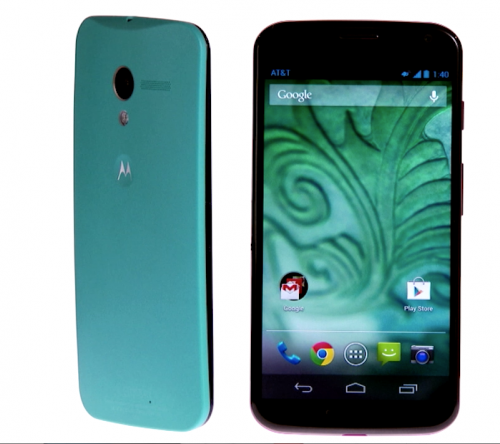Review: Moto X a good phone that should have been great

I really like Motorola's new Moto X smartphone. In a way, though, that's disappointing: But for a couple of shortcomings, I could have loved it.
Moto X is the first all-new smartphone to come from Motorola since Google took control of the company last year. With it, Google seems to be trying to break from Motorola's recent past of producing devices that only a geek could love.
Unlike the flat, rectangular shapes of the Droid line of phones, the new Moto X sports rounded corners and a gently curved back. Like many recent Android phones, it has a larger screen - in its case a 4.7-inch one - but thanks to the curves and the narrow borders around the display, it doesn't feel overly large. The back of the Moto X is made of plastic, but it fits tightly around its innards and seems solid. Overall, it feels great in the hand.
One of the cool things about the Moto X is that users can customize it when they order it. They can choose from among 18 different colors for the back of its case, two different colors for its front and seven different colors for its volume and power buttons. Users can also specify what wallpaper they want to have on their home screens and the greeting the phone will display when they turn it on.
Right now, these personalization options are only available on AT&T, but Motorola expects the other major carriers to offer them soon.
The Moto X includes a high-resolution OLED screen that looks great. It also offers longer life than the average smartphone. Part of the reason for the curve in the back of the phone is to make extra room for a custom-designed, longer-lasting battery. Motorola promises that you'll get up to 13 hours of talk time and 24 hours of mixed use. I didn't test those claims precisely, but found that I was easily able to make it through more than a day of intermittent use without having to recharge.
Similar to Apple's iPhone 5S, the Moto X has a processor that's dedicated to detecting and tracking motion. This allows the device to track movements even when it's not in active use and its main processors are turned off.
For example, if you simply want to check the time, all you have to do is pick up your phone or pull it out of your pocket; you don't have to push a power button first. You also can instantly launch the camera from a locked screen by picking up the device and twisting your hand twice. It doesn't start as fast as if you had a dedicated camera button, but it's pretty quick.
The Moto X also includes a technology that Motorola calls Active Display. When locked, the screen will flash on to alert you that you have a new text message or email or other notification. Although other devices have similar capabilities, Motorola has designed Active Display so that it's judicious with your battery life - it only illuminates the pixels it needs to display, and it won't turn on the screen if the phone is upside down.
I wasn't as impressed with some of the other features in the Moto X, including one that is supposed to be among its chief selling points. The Moto X includes a feature that allows you to access Google Now, a Siri-like voice assistant, without having to press a button or even touch the device. By simply saying "OK Google Now," the Moto X is supposed to launch the Google Now service and respond to your requests.
But I found the feature to be hit and mostly miss. For example, I tried to get it to set a timer while I was out running, but it didn't work. It didn't do anything even though I repeated "OK Google Now" multiple times.
Figuring that the problem might have stemmed from being outside in a noisy environment, I tried it again at my office and in my car. It worked maybe every fifth time. I even tried to retrain the phone to recognize when I said the key phrase. It still didn't work consistently.
Also disappointing was another key feature of the Moto X, an application called Motorola Assist. Among other things, that app is supposed, when you are driving, to read out to you any incoming text messages and to announce the names of any incoming callers. You're also supposed to be able to configure it to automatically send a text message in response to messages or calls alerting people that you are driving.
While the Moto X recognized when I was driving, it only rarely read out incoming text messages or announced the names of callers. Far more frequently, it would simply light up the screen without saying anything.
I wish those features worked better. Without them, the Moto X is still a very good phone. But so are a lot of other devices out there.
—-
MOTOROLA MOTO X SMARTPHONE:
-Likes: Solid feel; customizable case; long battery life; Active Display feature shows alerts and time without gobbling up battery; motion processor allows users to launch camera without having to press a button.
-Dislikes: Key feature - ability to launch Google Now with just your voice - rarely works, as does Motorola Assist app.
-Specs: 1.7GHz dual-core processor; 4.7-inch 1280 x 720 screen; 2 megapixel front and 10 megapixel rear cameras
-Price: $200 for 16GB model, $250 for 32GB model; both with a two-year contract
-On the Web: motorola.com
©2013 San Jose Mercury News (San Jose, Calif.)
Distributed by MCT Information Services



















